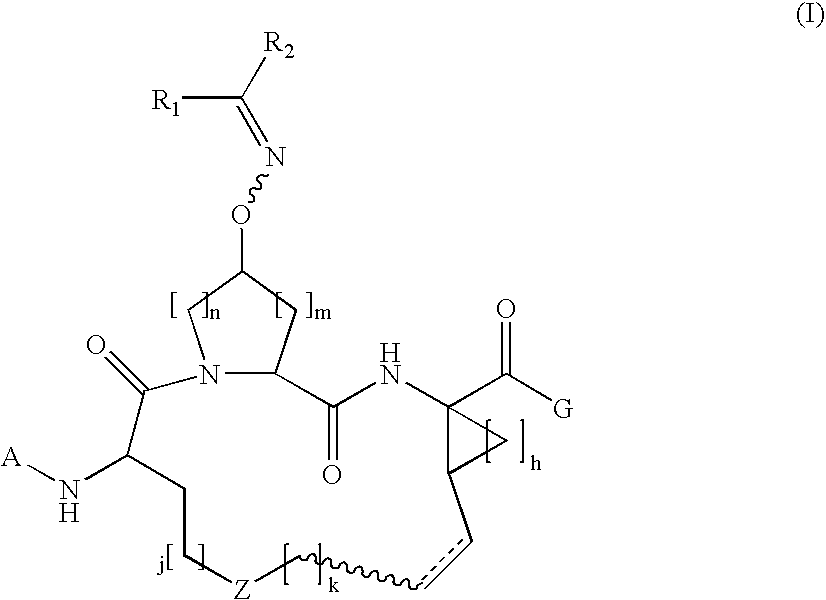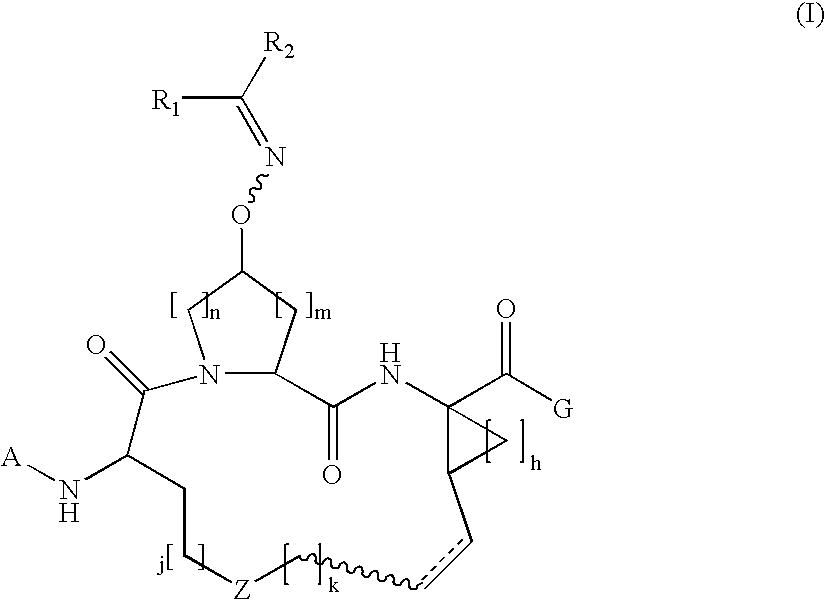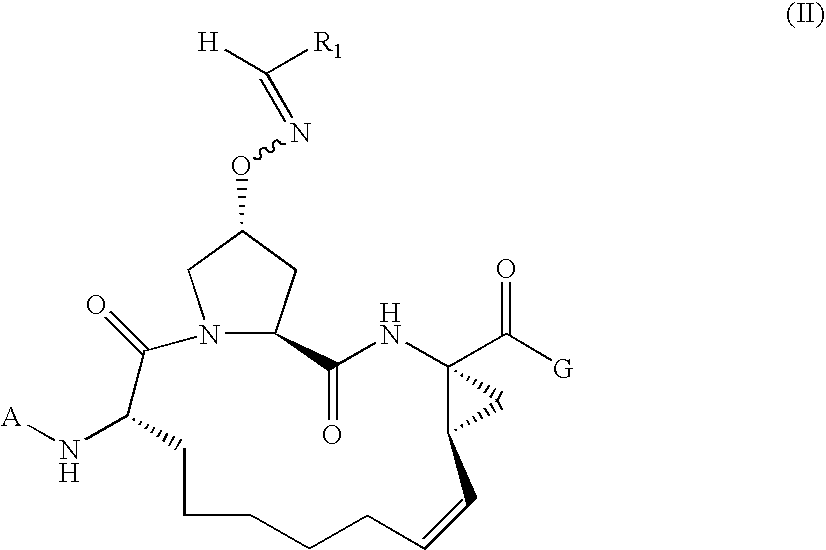Macrocylic oximyl hepatitis c protease inhibitors
a protease inhibitor and macrocylic oximyl technology, applied in the direction of peptides, drug compositions, peptides, etc., can solve the problems of interferon-related side effects, inability to reproduce infectious culture systems and small-animal models of hcv, and increasing public health problems, so as to inhibit serine protease activity
- Summary
- Abstract
- Description
- Claims
- Application Information
AI Technical Summary
Benefits of technology
Problems solved by technology
Method used
Image
Examples
example 1
Compound of Formula A, Wherein Rx═Boc and G═OEt
[0421]Step 1a.
[0422]To a solution of Boc-L-2-amino-8-nonenoic acid (1.36 g, 5 mol) and the commercially available cis-L-hydroxyproline methyl ester (1.09 g, 6 mmol) in 15 ml DMF, was added DIEA (4 ml, 4 eq.) and HATU (4 g, 2 eq). The coupling was carried out at 0° C. over a period of 1 hour. The reaction mixture was diluted with 100 mL EtOAc, and followed by washing with 5% citric acid 2×20 ml, water 2×20 ml, 1M NaHCO3 4×20 ml and brine 2×10 ml, respectively. The organic phase was dried over anhydrous Na2SO4 and then was evaporated, affording the desired dipeptide (1.91 g, 95.8%) that was identified by HPLC (Retention time=8.9 min, 30-70%, 90% B), and MS.
[0423]MS (ESI): m / z=421.37 [M+Na].
[0424]Step 1b.
[0425]The dipeptide from step 1a (1.91 g) was dissolved in 15 mL of dioxane and 15 mL of 1 N LiOH aqueous solution and the hydrolysis reaction was carried out at RT for 4 hours. The reaction mixture was acidified by 5% citric acid and extr...
example 2
Compound of Formula A, Wherein Rx═Cyclopentyloxycarbonyl and G═OEt
[0438]Step 2a.
[0439]To a flask containing the compound from step 1e (1.22 mmol) was added 4N HCl / dioxane (10 ml). The resulting mixture was stirred for 1 hr at room temperature. The mixture was then concentrated. The residue was precipitated with MTBE. The precipitates was filtered and washed with MTBE to give desired product.
[0440]MS (ESI): m / z=539.14 [M+H].
[0441]Step 2b.
[0442]To a solution of the compound from step 2a (1.22 mmol) in DCM was added DIEA (2.2 ml) and cyclopentylchloroformate (3 eq) at 0° C. The mixture was stirred for 1.5 h at room temperature. The reaction mixture was extracted with EtOAc. The organic extracts were washed with NaHCO3, brine, dried over Na2SO4, filtered and concentrated. The crude product was purified by silica gel chromatography to give 850 mg of desired product.
[0443]MS (ESI): m / z=651.21 [M+H].
[0444]Step 2c.
[0445]To a solution of compound from step 2b of Example 2 (0.41 mmol)) in EtO...
example 3
Compound of Formula B, Wherein Rx═Cyclopentyloxycarbonyl, R1═Methyl, R2═Phenyl and G=OH
[0447]Step 3a.
[0448]The mixture of compound from step 2c of Example 2 (0.05 mmol), acetophenone (0.1 mmol), HOAc (0.2 mmol) and pyridine (0.1 mmol) in EtOH was stirred at 60° C. overnight. The reaction mixture was extracted with EtOAc. The organic extracts were washed with 1M NaHCO3, brine, dried over Na2SO4, filtered and concentrated. The residue was purified by silica gel chromatography to give desired product.
[0449]Step 3b.
[0450]To a solution of the compound from step 3a in THF / MeOH was added 1NLiOH. The reaction mixture was stirred overnight at room temperature. After acidified with 1NHCl, the resulting mixture was extracted with EtOAc. The organic extracts were washed with water and concentrated. The residue was purified by preparative HPLC to give desired product.
[0451]MS (ESI): m / z=595.24 [M+H].
PUM
| Property | Measurement | Unit |
|---|---|---|
| mol % | aaaaa | aaaaa |
| temperature | aaaaa | aaaaa |
| emission wavelength | aaaaa | aaaaa |
Abstract
Description
Claims
Application Information
 Login to View More
Login to View More - R&D
- Intellectual Property
- Life Sciences
- Materials
- Tech Scout
- Unparalleled Data Quality
- Higher Quality Content
- 60% Fewer Hallucinations
Browse by: Latest US Patents, China's latest patents, Technical Efficacy Thesaurus, Application Domain, Technology Topic, Popular Technical Reports.
© 2025 PatSnap. All rights reserved.Legal|Privacy policy|Modern Slavery Act Transparency Statement|Sitemap|About US| Contact US: help@patsnap.com



